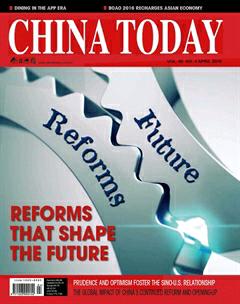Shanghai:Modernity and Tradition
THE international metropolis of Shanghai features both modernity and tradition. Located at the center of Chinas long coastline, the city has for the past century been a hub of convergence for commerce and wealth. One of Chinas first international commercial ports, Shanghai connects the country with the rest of the world.
Xian, capital of Shaanxi Province, showcases Chinas history from 2,000 years ago, while Beijings goes back 1,000 years. But for those interested in Chinas more recent history, Shanghai is the place. Since opening to the world as a commercial port in the mid-19th century, Shanghai has been a mirror of Chinas modern history. Personages such as the forerunner of Chinas democratic revolution Dr. Sun Yat-sen and his wife Soong Ching Ling, late Premier Zhou Enlai, and preeminent writer Lu Xun all lived here, and their former residences are well preserved. Shanghai is moreover the birthplace of the Communist Party of China (CPC). Its first clandestine meeting, when it was founded, took place on July 23, 1921 in an everyday residence at the city center.
Shanghai is a popular travel destination due to its rich cultural background, multiple sites of historical interest, and up-to-the-minute fashion. It is consequently a shopping paradise in China second only to Hong Kong. The Shanghai World Expo of 2010 and the Disney Resort that will open this June are treasured feathers in the cap of this metropolis.
Known in earlier times as Paris of the East, Shanghai has over the past century been synonymous with prosperity and modernity. Today, this fashionable metropolis, with its openness and global influence, draws world attention.
History
Shanghai has a long history, although its importance did not come to the fore until a few hundred years ago. Archeological research reveals that human habitation in this delta on the lower reaches of the Yangtze River began 5,000 years ago.
During the Spring and Autumn Period (770-476 BC) the area was part of Wu Kingdom territory. The story of the revenge of King Fuchai of the Wu Kingdom on King Goujian of the Yue Kingdom is known throughout China. When Fuchai defeated Yue to avenge his father, Goujian surrendered and presented the beauteous Xishi as a tribute to Fuchai. After surviving three years of servitude, Goujian summoned his resolve and forces and eventually vanquished Wu.
Shanghais original name Hudu originates in that for a common fishing tool. Today, many still call Shanghai Hu for short. It was not until the 10th century that the name Shanghai came about. In the 13th century, the government department in charge of maritime foreign trade was set up in Shanghai. By the 14th century, Shanghai had become the center of Chinas textile industry, and was a thriving commercial economy. In 1685, the Qing Dynasty(1644-1911) government set up its customs office in Shanghai. It gradually became a major trading port and grain transportation hub.

After the First Opium War ended, Shanghai was appointed in 1843 as a treaty port for ChineseWestern trade. Situated in the middle of Chinas north-south coastline and at the mouth of the Yangtze River, Shanghai was also adjacent to such time-honored and prosperous cities as Suzhou, Hangzhou, and Nanjing. It was also a reasonable distance from other countries in East Asia and Southeast Asia. By virtue of this advantageous geographical location, Shanghai received huge influxes of foreign goods and foreign capital. People from the world over flocked to the city to open businesses that ranged from banks to wharf management. It replaced Guangzhou as the countrys foreign trade center and became a fabulous Far Eastern metropolis.
The U.K. first delimited its concession in Shanghai in 1854, and the U.S. followed suit, as did France in 1849. After 1863, when the U.K. and U.S. concessions merged, the city was divided into three parts – the Chinese section, the international settlements, and the French concession. As a port where foreign colonialists dumped their commodities and snaffled Chinas goods and wealth, Shanghai was regarded as an adventurers paradise.
The concessions were recovered by the Chinese government after WWII ended. Upon establishment of the Peoples Republic of China in 1949, Shanghai was ratified as one of the countrys first municipalities directly under the central government.
Shanghai Culture
The culture of this Eastern metropolis is a blend of the longstanding traditions and way of life prevailing in regions south of the Yangtze River and Western modern industrial civilization. Shanghai and Beijing represent opposing poles of Chinese culture. Compared with that of the more conservative Beijing, Shanghai culture is a fusion of China and the West, and is hence the more modern, commercial and down-to-earth of the two.
Before the port opened to foreign trade, Shanghai was largely affiliated to the sensitive, delicate culture of regions south of the Yangtze River. When the city opened to the wider world, migrants infused into local culture a pioneering spirit born of adventure and exploitation.
Western culture also greatly influenced Shanghai. Its unique ambience took shape as the city transformed from a small town to the heart of the countrys economy and trade. Shanghai culture thus combines Chinas classical elegance with international modernity and fashion. Having always been ready to embrace diversified and exotic cultures it has also remained loyal to Chinese traditions, and accommodates both elite and pop cultures, so displaying openness, innovation, and diversity.

